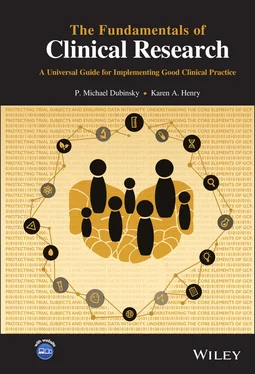Policies developed or adopted by governments provide another source or format for requirements. Laws and regulations are often derived from important policy statements. For human clinical trials the fundamental principles and practices for the ethical treatment of subjects have been drawn from The Nuremburg Code, Declaration of Helsinki and Belmont Report which are generally recognized as being the “gold standards” for the protection of human subjects participating in clinical trials. Of the three the Declaration of Helsinki undergoes periodic updation. These documents will be mentioned a number of times in this text and you will study them in detail if you take courses in ethics and informed consent.
2.5 Guidelines and Guidance Materials
There are other types of documents which provide insight and understanding as to how regulatory authorities interpret compliance with laws and regulations. These include materials titled: good guidance practices, guidelines, reflection papers, best practices, standards, and notices. These documents do not generally have the legal standing of laws and regulations but they often represent the combined opinion of regulatory and scientific experts and therefore carry significant weight when assessing compliance with the law.
The exact definition for these materials does differ between regulatory authorities so it is important to review the definitions to be certain one understands whether they are essentially requirements or optional. For example in the European Union the EMEA offers the following on guidelines:
The European Medicines Agency's Committee for Medicinal Products for Human Use prepares scientific guidelines in consultation with regulatory authorities in the European Union (EU) Member States, to help applicants prepare marketing authorisation applications for human medicines. Guidelines reflect a harmonised approach of the EU Member States and the Agency on how to interpret and apply the requirements for the demonstration of quality, safety, and efficacy set out in the Community directives.
The Agency strongly encourages applicants and marketing authorisation holders to follow these guidelines. Applicants need to justify deviations from guidelines fully in their applications at the time of submission. Before that, they should seek scientific advice, to discuss any proposed deviations during medicine development.
The guidelines are complementary to European Pharmacopoeia monographs and chapters: [1]
The FDA on the other hand states in their regulations defining Good Guidance Practices: Good guidance practices (GGP's) are FDA's policies and procedures for developing, issuing, and using guidance documents. Guidance documents are documents prepared for FDA staff, applicants/sponsors, and the public that describe the agency's interpretation of or policy on a regulatory issue. Guidance documents include, but are not limited to, documents that relate to: The design, production, labeling, promotion, manufacturing, and testing of regulated products; the processing, content, and evaluation or approval of submissions; and inspection and enforcement policies [2].
Best practices are usually published by industry or a professional organization. The importance of the content is linked to whether it receives any specific endorsement by a regulator or officials from regulatory agency. Very often best practices address topics that are not specifically found in laws or regulations. One example is handling regulatory inspections. Industry has developed their own set of best practices for interacting with regulatory inspectors during inspections with the goal of being forthright and compliant without being presumptuous. Another example of best practices might be recruiting and retaining subjects in clinical trials.
Notices are usually issued as one time alerts or reminders which are sent by regulatory authorities based on incidents which occur and which carry some importance in terms of protecting subjects or data integrity. Notices are also used by some regulatory authorities to advise sponsors, investigators, and others clinical trial players of regulatory interpretations they have made and which are enforceable. The country of India’s Central Drug Standards Control Organization (CDSCO) uses Notices/Notifications in that manner.
Reflection papers are unique to the EU/EMA and they are a compellation of general issues on a topic which should be taken into consideration. An example is the EMA’s Reflection paper for laboratories that perform the analysis or evaluation of clinical trial samples . Its purpose is to provide laboratories that perform the analysis or evaluation of human samples collected as part of a clinical trial, with information that will help them develop and maintain quality systems which will comply with relevant European Union Directives, national regulations and associated guidance documents [3].
Standards as such are not prevalent in the human clinical trial arena for pharmaceutical drugs. There are some clinical trial‐related documents which have universal application and acceptance and are referred to as “standards.” The ICH E6(R2) guideline being a primary example. Standard setting organizations such as the International Organization for Standardization (ISO) have played a role in setting globally accepted standards for medical devices for some time and the Standard Clinical investigation of medical devices for human subjects – Good clinical practice, ISO 14155 [4] is an example that fits neatly with our discussion of human clinical trials.
The level of importance that is assigned to these various guidance materials is usually a function of who issues the document and what the issuing party says about its status and importance at the time of issuance.
2.6 Regulatory/Competent Authority Organizations
The second element in the regulatory environment matrix is the regulatory or competent authority. The regulatory authority is charged or assigned the task of implementing and enforcing the laws and regulations, i.e. regulatory requirements. ICH E6(R2) highlights the roles of application review and inspection for regulatory authorities. In fact their responsibilities include other tasks for example, inspecting clinical trial activities, enforcing the requirements, and educating regulated entities. Understanding the roles and responsibilities of the regulatory authority, how they are organized, and what their approaches are to implementation of the applicable laws and regulations adds value and is essential to conducting clinical trials in conformance with GCP.
There are internet resources which provide listings and links to many of the global regulatory authorities responsible for drug/device regulation in general and the oversight of clinical trials in particular. It is likely you have already accessed many of the webpages for global regulatory authorities.
While the US FDA does not serve as the single model for global regulatory authorities it represents one of the best known and seasoned regulators. If we look back at the introductory chapter you will note that many of the key events associated with the evolution of clinical trial and pharmaceutical product regulation took place in the United States and the growth of clinical trial regulation is directly linked to the growth of the US FDA as an organization.
Using the FDA’s review process of applications for permission or authorization to conduct clinical trials does provide a somewhat generic blueprint for application review.
First a trial sponsor submits an application which is assigned to one of the three FDA headquarters’ offices:
1 Center For Drug Evaluation and Research (CDER) – INDs
2 Center for Biologics Evaluation and Research (CBER) – INDs and IDEs
Читать дальше












